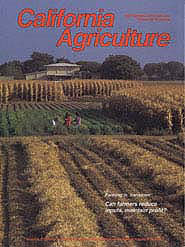All Issues

Farming in transition: Can farmers reduce inputs, maintain profit?
Cover:
UC researchers are comparing organic, low-input and conventional farming systems in the Sustainable Agriculture Farming Systems project at UC Davis. At the research site, dried pinto beans (in the foreground) mature black beans and corn are ready for fall harvest, Photo by Jack Kelly Clark
September-October 1994
Volume 48, Number 5
Volume 48, Number 5





